| EQUINETOURISM - EDITORIAL - EXMOOR PONY BREED - Foal Handling |
|

|
| NATIVE PONIES - Handling Exmoor Pony Foals |
Article & Pictures (below) about handling and training an Exmoor Colt Foal - head collars, leading, loose schooling, socialising and weaning.
By Dawn Westcott of Holtball Exmoors |
| EXMOOR PONY FOALS - Headcollars & Loose Schooling - Introduction |
| Exmoor ponies, one of the UK's twelve Native Pony breeds, have remained genetically pure since the Ice Age and are considered to be a truly 'prehistoric' little horse. Unfortunately, their small numbers (only about 3,000 worldwide) mean they are listed as an Endangered Breed, but much conservation work is being done to preserve and protect this remarkable pony - one of the UK's most ancient national treasures!
Exmoor ponies live in both semi-feral, free-living herds and also 'in ground' in domestic pastures. The free living herds can be found within Exmoor National Park in Somerset, and in small pockets around the UK and overseas. Once they have been socialised to human contact and their trust has been won, Exmoor ponies can make fantastic riding and performance ponies. They are extremely robust, strong, well conformed and intelligent. Their evolution has involved them thinking for themselves and making decisions for their own survival - so the Exmoor pony has a bright, sharp, questioning character and a strong sense of right and wrong (as they see it...).
Positive, Trust-Based Training Methods
The training methods that work best with Exmoor ponies are positive and trust-based. The growing trend for working 'at liberty' with horses and ponies, understanding horse psychology and behaviour, and considering their well being and happiness in any activity they are involved in, is the key to unlocking the best from an Exmoor pony. Once trust is established on the ground, Exmoor ponies will accept you on their backs and, with their strength, speed, intelligence and sure footedness, they ride like 'little horses' and are extremely comfortable. They have natural rhythm, endurance - and can jump like stags! Managing Exmoor Ponies
At Holtball Exmoors (web page), our ponies live in small herds, with our foundation stallion, Hawkwell Versuvius, running with mares and youngstock all year round. Once youngstock is weaned, they are introduced into another herd with youngstock and older ponies to guide them. A natural management system means the ponies roam freely from the pasture into their corralls and shelter and they have company at all times. Allowing the young ponies company continues in their training. When we are introducing a foal to wearing a headcollar, leading, handling and loose schooling, we will always ensure there is an older, more experienced pony (or ponies) involved. The foal gains great confidence from the calmness of his companions, and learns more easily what is expected of him, when others can demonstrate by example. Headcollars and Loose Schooling for Foals
In this two-part session below, we are first of all giving our foal the opportunity to discover his new surroundings completely free of any restraint, so we have taken the headcollar off. This is his first ever time in the schooling area and he has never before been out of sight from his mother for longer than about five minutes, so we have brought his father with him to see what can be achieved. This colt lives with both his sire and dam, so they are well socialised. This is the start of the weaning process, which we like to do gradually. The first step is for him to willingly approach his handler and have the head collar back on again.
The stallion then shows his six month old son how to loose school around his handler. The aim of these short sessions is to allow the foal to move 'at liberty', and learn to focus on the handler, returning to the handler when asked. In this way, the foal becomes confident of both going away and returning to the handler, and becomes easier to lead, 'catch' and handle. The sessions are also fun and the older ponies usually take enormous pride in showing a youngster what to do. The foal is too intelligent for us to try to 'con' into thinking we are not a 'predator'. He knows full well that humans are predators. But, because we haven't hurt him, he is willing to consider that we might be 'protectors' and therefore worth dealing with. So it is very important for us to not abuse our postion of trust with this foal, and convince him that we are, indeed, his protectors, even though we are 'predators'. This is an ongoing process that he will question every day...
In the Loose Schooling photographs below, we were astonished at how calm the foal was, and how he both looked to his father for guidance, but was happy to approach the handler and remain calm and focussed. These initial sessions only need to be about five minutes. The foal was then given a feed so there is a positive consequence for going to the barn.
The sections below show us putting on a headcollar, and then introducing the colt to his first ever loose schooling session, with his sire.
|
| Putting a headcollar on an Exmoor colt foal |
| This is the first time this colt foal has been given his liberty in a school outside of his familiar barn and field. After leading him around the school with his father, we removed his headcollar so he could explore the area on his own. Then his handler asked him to approach so she could put his headcollar back on. When we introduce a foal to a headcollar for the first time, we don't leave it on - and the foal grows used to having the headcollar on and off, so he is not scared of it. Here you can see me approaching the foal and how he accepts the headcollar happily. He is free to move around in the entire schooling area, and often, with this choice, he will choose to remain with his handler. |
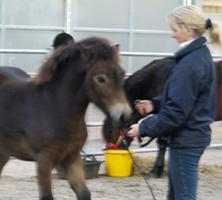 |
|
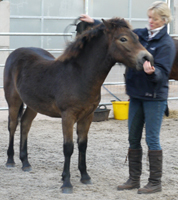 |
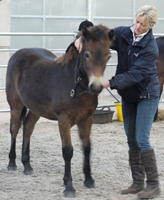 |
| I a pproach the foal honestly, so he can see the headcollar and knows my intention |
I let him sniff it if he wants to. The stallion is standing behind him, so he will also be aware that his father is calm and telling him it's 'OK'. |
Reassuring him with one hand, I slowly but smoothly, take the other hand with the headcollar up and over his neck, caressing him as I move it over his neck |
I slide it down under his neck - again with smooth, soft movements. The foal prefers me to be smooth - neither 'jerky' or 'creepy. I try to keep my breathing calm and even, as he is reading me. |
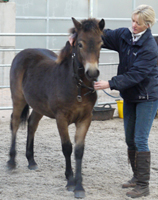 |
|
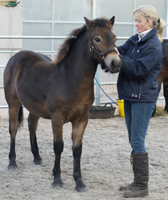 |
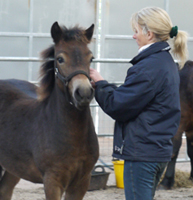 |
| I don't rush, but I don't pause too much either. The foal appreciates my calmness but also wants to get on with it. |
I'm careful not to look him directly in the eye, and carefully bring the strap to the buckle to do up. At no point am I restraining the foal - he is happy to stand there. |
If he were to step backwards, I would go softly with him. When he pauses, I pause. I do up the headcollar. |
If I'm relaxed and breathing, the foal will be relaxed and breathing. Here his ears are pricked. He is alert, but he is also trusting and has hardly moved a step. |
|
| Introducing the Colt Foal to Loose Schooling (duration of first session: About 5 minutes) |
| This first ever loose schooling session - and first time in this building - for the colt is kept to a minimum, with just a couple of circuits in each direction. This is a huge step for a youngster and it's important that he is not 'over-faced' and enjoys the experience. |
|
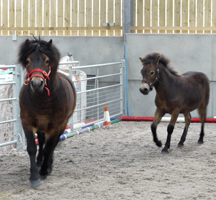 |
|
| The colt follows his father - the stallion is concentrating on doing the right thing and the colt is playful, not frightened. |
Now the colt is closely watching the stallion and copying him |
The colt is gregarious but the stallion remains totally focussed on doing the right thing |
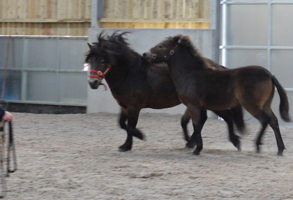 |
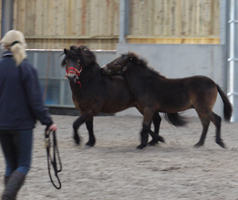 |
|
| As soon as I slightly alter my body language to a passive stance, the stallion is making the decision to come in |
The stallion is focussed and comes to me |
So does the colt - who comes right up to me - you can see the rope on the right |
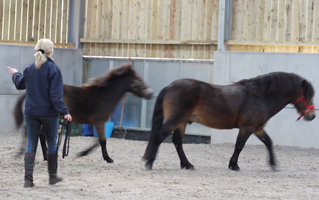 |
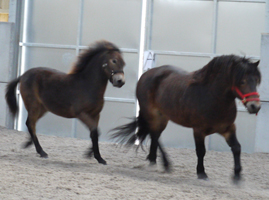 |
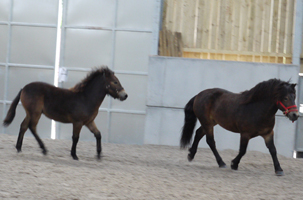 |
| After stroking them, I ask them to go in the opposite direction |
Now the colt is really getting the idea |
The stallion concentrates on setting a perfect example for his son to follow |
|
|
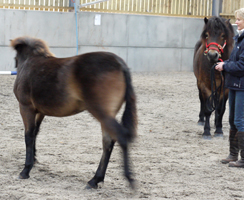 |
| The colt continues to be playful but the stallion ignores this |
The stallion is totally tuned in to my energy. Throughout this I have used only slight hand movements. He slows to a walk as I start to go 'passive'. |
The stallion comes straight into me. The colt starts to wheel in. |
|
|
|
| He walks right up to me. |
And this time is very comfortable to be back in the centre, in what we have established as the 'comfort zone' |
The colt chooses to remain with me and remains calm and relaxed. |
| Footnote: It is interesting to note that, after this session, the colt is more confident about leading in hand and is even happy to walk in front of the stallion on his way back to his field. This colt currently lives with the stallion and mares, until weaning, and the stallion has been with this colt since the day he was born, so they are well socialised together. We find it beneficial to school ponies together in their family/living group. Group social behaviours are already clearly established and from this, learning with humans increases. |
|
| Weaning the Colt Foal |
| At seven months old, Elbrus is ready for weaning. After a few sessions with his sire in the school, today, we took Elbrus for his first solo walk and introduced him to his yearling brother. |
 |
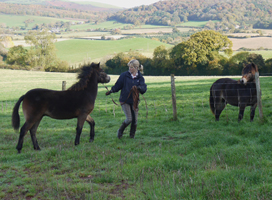 |
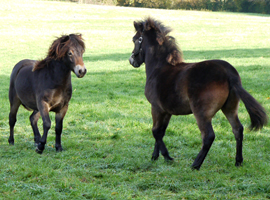 |
| Leading out on his own for the first time. |
Elbrus and Monty take a look at one another over the fence. |
And are then introduced in the field. We make sure there is plenty of space and try to avoid steep inclines while youngsters get to know each other. |
 |
 |
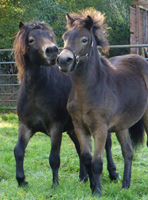 |
| Both colts have been well socialised with other ponies so they are good natured about meeting each other. |
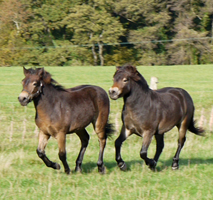 |
|
 |
|
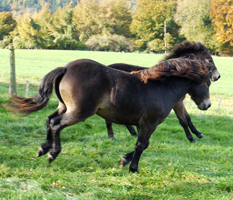 |
|
| There is great excitement, particularly for Monty, who now has a young playmate. Looks like Elbrus is going to hold his own though. |
 |
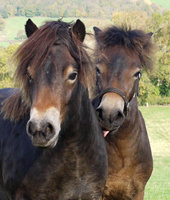 |
|
| Happy to know each other |
Elbrus gives Monty a friendly lick |
Time to go back to his sire and dam - Elbrus comes up to have the lead rope clipped on. |
| This first session lasted a couple of hours. We will look to increase the time that Elbrus spends away from his dam until he is properly socialised with Monty and can accept this new change in his life happily. The mare is getting ready to wean and is not showing signs of distress while he is away. |
� |
| For More Information |
|
For more information on Positive, Trust-Based methods of Horsemanship see the Natural Horsemanship section for a list of trainers.
For more information on Monty Roberts see the Monty Roberts section and the Monty Roberts Online University
CLICK HERE for more information on Vanessa Bee and The Good Horsemanship Society
CLICK HERE for more information about Horse Agility, contact Vanessa Bee www.horseagilitygb.com
Copyright: Dawn Westcott 2010
Please note that this is not a lesson and we do not advise you try anything featured here without the appropriate training. All horses loose schooled together at Holtball Exmoors are well socialised. Dawn Westcott holds the Monty Roberts Introductory Certificate in Horsemanship, is fully insured as a natural horsemanship practitioner and undertakes ongoing training with horsemen including Rodrigo da Costa Matos and Vanessa Bee. This feature is a descriptive article and should not be construed as a lesson.
|
|
� Horse riding holidays, equestrian events and shows, horseback vacations, equine directory, good horsemanship, horse holidays, uk and worldwide
�
ADVERTISE on Equinetourism.co.uk - Click here
SEARCH FOR CONTENT ON EQUINETOURISM.CO.UK |
�
Also see www.EquineTourismCommunity.com and www.EquineTourism.com
email: [email protected] - Telephone 00 44 (0)1643 862785
www.EquineTourism.co.uk is owned by Happy Horses Ltd, Holt Ball, Luccombe, Minehead, Exmoor, Somerset TA24 8SZ
Full worldwide copyright and all rights retained �2004-2014 ongoing Happy Horses Ltd. Please read our Disclaimer
|

